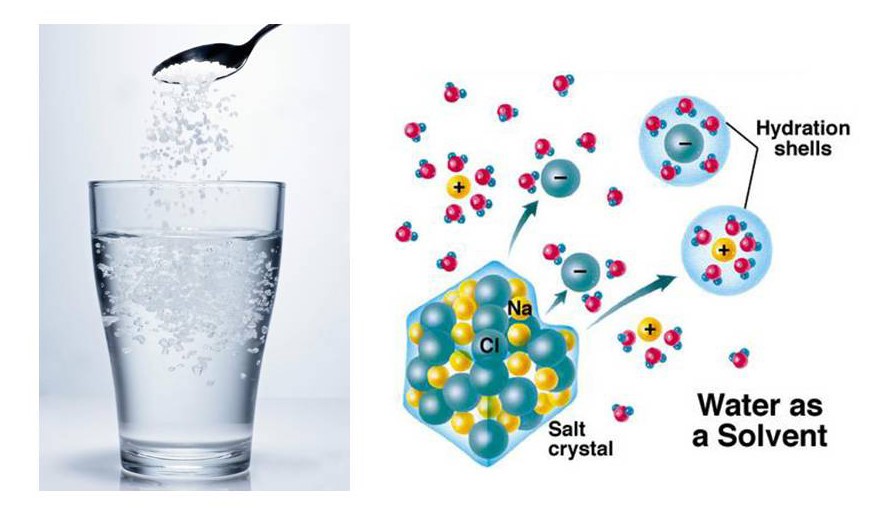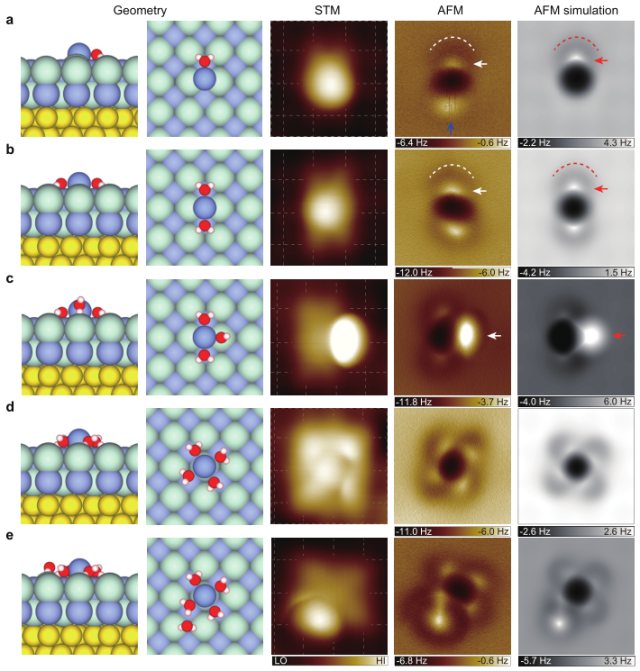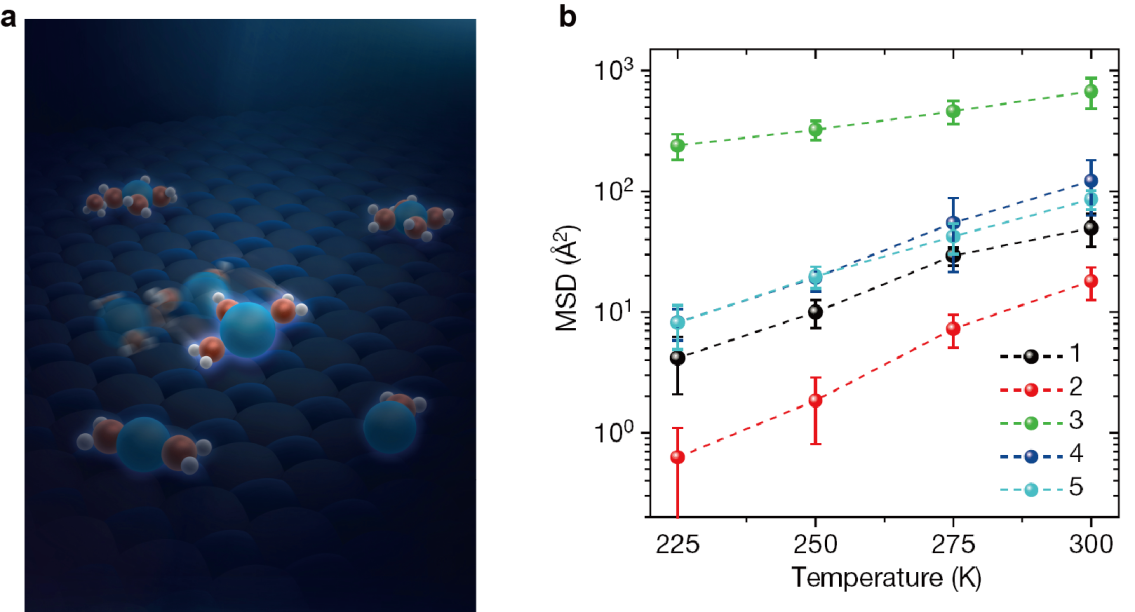Magic-number water molecules speed up the hydrated ions at interfaces
It is well known that salts will dissolve in the water and the water molecules are bounded with the dissolved ions, forming hydrated ions (Figure 1). The existence of the hydrated ions has already been realized at the end of 19 century. To date, the first experimental trial to confirm this was done by German chemist Walther Nernst (Nobel Laureate, 1920) and his students using so-called transference experiments. For the following more than one hundred year, massive experiments and theoretical calculations have been carried out to understand the microscopic structure and dynamics of hydrated ions. However, many key issues are still under debate so far, such as the water number and configuration in the hydration shells, the effect of hydrated ions on the water structure and dynamics, the microscopic factors that govern the transport of the hydrated ions, and so on. The situation becomes even more complicated when the interfaces are introduced, due to the competing interaction among ions, water and surfaces. The main reason lies in the lack of experimental tools, which can really 'see' and 'manipulate' the hydrated ions with atomic precision.
Figure 1 NaCl is dissolved in water. The water molecules are bounded with the dissolved ions, forming hydrated ions.
Now, the teams led by Prof. Ying Jiang, Prof. Limei Xu and Prof. Enge Wang of International Center for Quantum Materials (ICQM) of Peking University, in collaboration with Prof. Yiqin Gao of College of Chemistry and Molecular Engineering of Peking University and Dr. Pavel Jelínek from Institute of Physics, the Czech Academy of Sciences, unravel, for the first time, the microscopic structures of Na+ ion hydrates on the NaCl surface and discover a magic-number effect on the transport of ion hydrate, through a combined study using scanning probe microscope (SPM), density functional theory (DFT) calculations and molecular dynamics (MD) simulations. This work is published in Natureon May 14, 2018.
The first challenge of this work is to prepare single ion hydrates on a surface, with tunable number of water molecules. To this end, the researchers figured out a novel method to manipulate individual ions and water molecules by scanning tunneling microscopy (STM). They were able to construct individual Na+ hydrates containing one-to-five water molecules on a NaCl(001) surface, which paves the way for high-resolution imaging of the ion hydrates. Another challenge is to avoid the disturbance of the scanning probes on the ion hydrates, which are highly fragile and flexible. To overcome this difficulty, the researchers developed a weakly-perturbative imaging technique, which relies on the weak high-order electrostatic force by noncontact atomic force microscopy (AFM). Such a technique yields the first-ever atomically resolved images of the Na+ hydrates, in direct comparison with DFT calculations and simulations (Figure 2).
Figure 2 The atomically resolved images of different Na+ ion hydrates. From the left to right column: atomic model (Geometry), scanning tunneling microscopy (STM), atomic force microscopy (AFM) and AFM simulation. Image size: 1.5 nm ×1.5 nm.
Furthermore, the researchers compared the mobility of different ion hydrates in a well-controlled manner via the inelastic electron tunneling technique. They found an interesting magic-number effect: the Na+ hydrated with three water molecules diffuses one to two orders of magnitude faster than other Na+ hydrates and even much faster than the Na+ in dilute bulk solution (Figure 3). Ab initio calculations and MD simulations revealed that such high ion mobility arises from the degree of the symmetry match between the hydrate and substrate. The magic-number effect applies within a wide range of temperatures (up to room temperature) according to the classical MD simulations. Besides, they found that the magic-number effect applies for many salt ions, suggesting its generality.
Figure 3 Magic number effect in the transport of ion hydrates. a, Schematic showing that the Na+ hydrated with three water molecules diffuses much faster than other Na+ hydrates. b, Mean Square Displacement (MSD) in 1 ns of Na+•nH2O (n = 1–5) between 225 K and 300 K.
This work established, for the first time, direct correlation between the atomic structure and transport mechanism of hydrated ions, which may completely renovate the traditional understanding of ion transport in nanofluidic systems. In addition, those results point out a new way to control the ion transport in nanofluidic systems by interfacial symmetry engineering, which is of great importance for an extremely wide range of technologically and biologically relevant processes, including corrosion, water desalination, electrochemistry, and biological ion channel, etc.. The techniques developed in this work can be easily extended to different ions and other hydration systems, opening up the possibility of studying various hydration processes down to atomic scale.
Dr. Jinbo Peng (now a Humboldt fellow), Duanyun Cao of International Center for Quantum Materials (ICQM) of Peking University and Zhili He of College of Chemistry and Molecular Engineering of Peking University are the co-first authors of this work. Prof. Ying Jiang (SPM), Prof. Enge Wang (DFT), Prof. Yiqin Gao (MD) and Prof. Limei Xu (DFT) are the co-corresponding authors.This work received supports from National Natural Science Foundation of China, Ministry of Science and Technology of China, Chinese Academy of Sciences, and Collaborative Innovation Center of Quantum Matter.
Paper link:J. Peng, D. Cao, Z. He, J. Guo, P. Hapala, R. Ma, B. Cheng, J. Chen, W.-J. Xie, X.-Z. Li, P. Jelínek, L.-M. Xu*, Y.-Q. Gao*, E.-G Wang*, Y. Jiang*, 'The effect of hydration number on the interfacial transport of sodium ions', Nature, DOI: 10.1038/s41586-018-0122-2 (2018) (https://doi.org/10.1038/s41586-018-0122-2)


